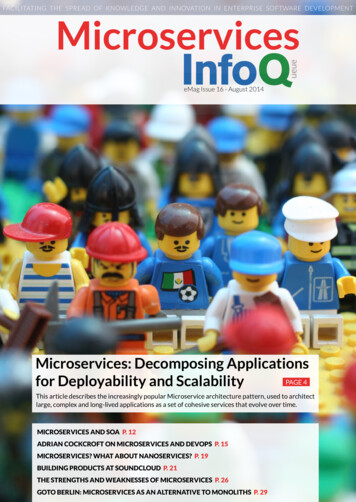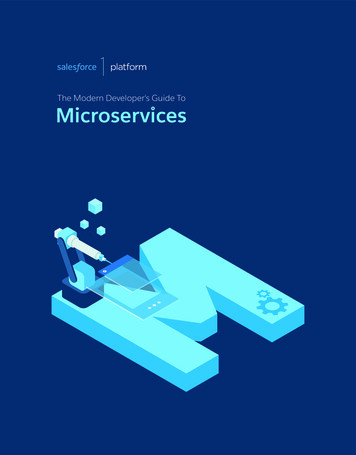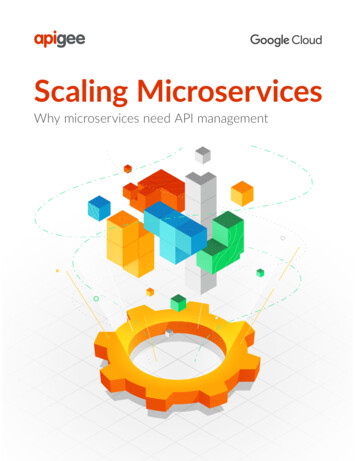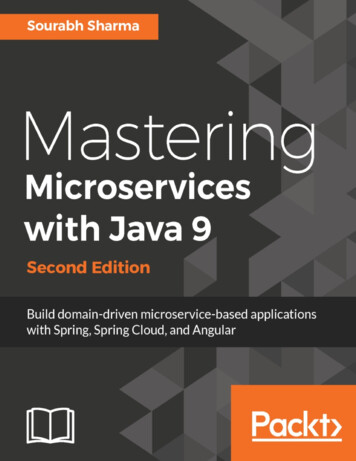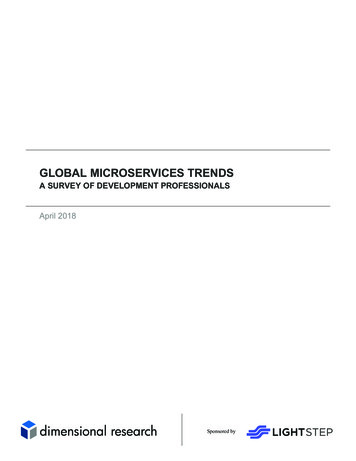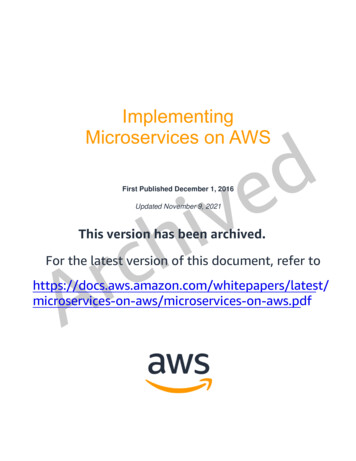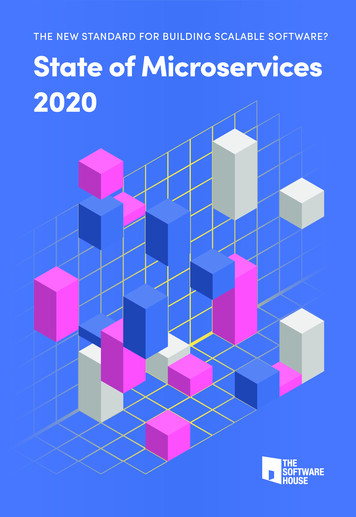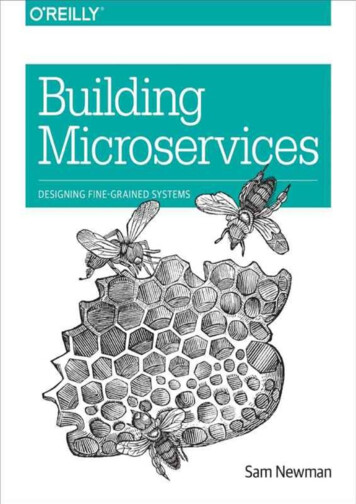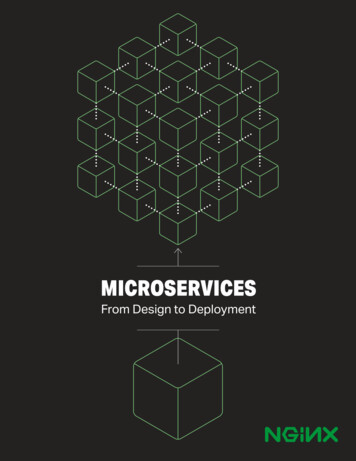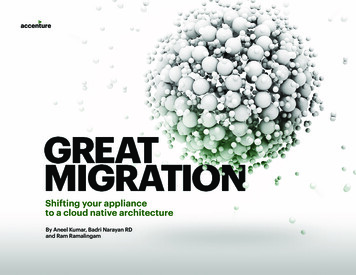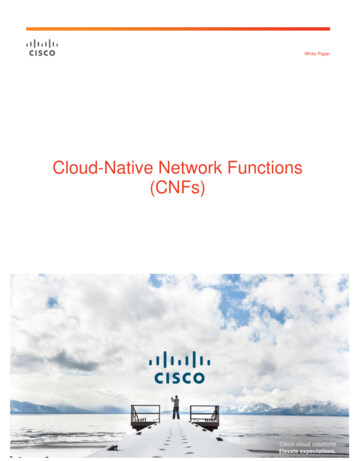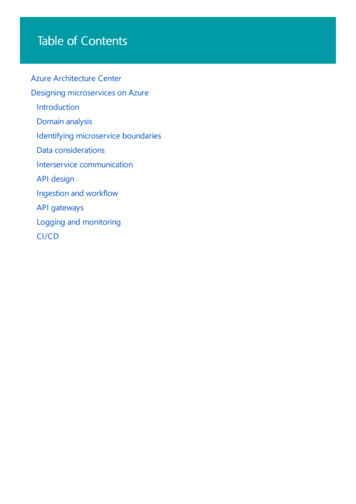
Transcription
Table of ContentsAzure Architecture CenterDesigning microservices on AzureIntroductionDomain analysisIdentifying microservice boundariesData considerationsInterservice communicationAPI designIngestion and workflowAPI gatewaysLogging and monitoringCI/CD
Azure Application Architecture GuideA guide to designing scalable, resilient, and highly available applications, based on proven practices that we have learnedfrom customer engagements.Reference ArchitecturesA set of recommended architectures for Azure. Each architecture includes best practices, prescriptive steps, and adeployable solution.Cloud Design PatternsDesign patterns for developers and solution architects. Each pattern describes a problem, a pattern that addresses theproblem, and an example based on Azure.Building Microservices on AzureThis multi-part series takes you through the process of designing and building a microservices architecture on Azure. Areference implementation is included.Azure Data Architecture GuideA structured approach to designing data-centric solutions on Microsoft Azure.Best Practices for Cloud ApplicationsBest practices for cloud applications, covering aspects such as auto-scaling, caching, data partitioning, API design, andothers.Designing for ResiliencyLearn how to design resilient applications for Azure.Azure Building BlocksSimplify deployment of Azure resources. With a single settings file, deploy complex architectures in Azure.Design Review ChecklistsChecklists to assist developers and solution architects during the design process.Azure Virtual Datacenter
When deploying enterprise workloads to the cloud, organizations must balance governance with developer agility. AzureVirtual Datacenter provides models to achieve this balance with an emphasis on governance.Azure for AWS ProfessionalsLeverage your AWS experiences in Microsoft Azure.Performance AntipatternsHow to detect and fix some common causes of performance and scalability problems in cloud applications.Run SharePoint Server 2016 on AzureDeploy and run a high availability SharePoint Server 2016 farm on Azure.Run SAP HANA on AzureDeploy and run SAP NetWeaver and SAP HANA in a high availability environment on Azure.Identity Management for Multitenant ApplicationsUnderstand the best practices for multitenancy, when using Azure AD for identity management.Azure Customer Advisory TeamThe AzureCAT team's blogSQL Server Customer Advisory TeamThe SQLCAT team's blog
Designing, building, and operating microservices onAzure1/8/2018 6 min to read Edit OnlineMicroservices have become a popular architectural style for building cloud applications that are resilient, highlyscalable, independently deployable, and able to evolve quickly. To be more than just a buzzword, however,microservices require a different approach to designing and building applications.In this set of articles, we explore how to build and run a microservices architecture on Azure. Topics include:Using Domain Driven Design (DDD ) to design a microservices architecture.Choosing the right Azure technologies for compute, storage, messaging, and other elements of the design.Understanding microservices design patterns.Designing for resiliency, scalability, and performance.Building a CI/CD pipeline.Throughout, we focus on an end-to-end scenario: A drone delivery service that lets customers schedule packagesto be picked up and delivered via drone. You can find the code for our reference implementation on GitHubReference implementationBut first, let's start with fundamentals. What are microservices, and what are the advantages of adopting amicroservices architecture?Why build microservices?In a microservices architecture, the application is composed of small, independent services. Here are some of thedefining characteristics of microservices:Each microservice implements a single business capability.A microservice is small enough that a single small team of developers can write and maintain it.Microservices run in separate processes, communicating through well-defined APIs or messaging patterns.Microservices do not share data stores or data schemas. Each microservice is responsible for managing its owndata.Microservices have separate code bases, and do not share source code. They may use common utility libraries,however.Each microservice can be deployed and updated independently of other services.Done correctly, microservices can provide a number of useful benefits:Agility. Because microservices are deployed independently, it's easier to manage bug fixes and featurereleases. You can update a service without redeploying the entire application, and roll back an update ifsomething goes wrong. In many traditional applications, if a bug is found in one part of the application, itcan block the entire release process; as a result, new features may be held up waiting for a bug fix to beintegrated, tested, and published.Small code, small teams. A microservice should be small enough that a single feature team can build, test,and deploy it. Small code bases are easier to understand. In a large monolithic application, there is a
tendency over time for code dependencies to become tangled, so that adding a new feature requirestouching code in a lot of places. By not sharing code or data stores, a microservices architecture minimizesdependencies, and that makes it easier to add new features. Small team sizes also promote greater agility.The "two-pizza rule" says that a team should be small enough that two pizzas can feed the team. Obviouslythat's not an exact metric and depends on team appetites! But the point is that large groups tend be lessproductive, because communication is slower, management overhead goes up, and agility diminishes.Mix of technologies. Teams can pick the technology that best fits their service, using a mix of technologystacks as appropriate.Resiliency. If an individual microservice becomes unavailable, it won't disrupt the entire application, as longas any upstream microservices are designed to handle faults correctly (for example, by implementing circuitbreaking).Scalability. A microservices architecture allows each microservice to be scaled independently of the others.That lets you scale out subsystems that require more resources, without scaling out the entire application. Ifyou deploy services inside containers, you can also pack a higher density of microservices onto a single host,which allows for more efficient utilization of resources.Data isolation. It is much easier to perform schema updates, because only a single microservice isimpacted. In a monolithic application, schema updates can become very challenging, because different partsof the application may all touch the same data, making any alterations to the schema risky.No free lunchThese benefits don't come for free. This series of articles is designed to address some of the challenges of buildingmicroservices that are resilient, scalable, and manageable.Service boundaries. When you build microservices, you need to think carefully about where to draw theboundaries between services. Once services are built and deployed in production, it can be hard to refactoracross those boundaries. Choosing the right service boundaries is one of the biggest challenges whendesigning a microservices architecture. How big should each service be? When should functionality befactored across several services, and when should it be kept inside the same service? In this guide, wedescribe an approach that uses domain-driven design to find service boundaries. It starts with Domainanalysis to find the bounded contexts, then applies a set of tactical DDD patterns based on functional andnon-functional requirements.Data consistency and integrity. A basic principle of microservices is that each service manages its owndata. This keeps services decoupled, but can lead to challenges with data integrity or redundancy. Weexplore some of these issues in the Data considerations.Network congestion and latency. The use of many small, granular services can result in moreinterservice communication and longer end-to-end latency. The chapter Interservice communicationdescribes considerations for messaging between services. Both synchronous and asynchronouscommunication have a place in microservices architectures. Good API design is important so that servicesremain loosely coupled, and can be independently deployed and updated.Complexity. A microservices application has more moving parts. Each service may be simple, but theservices have to work together as a whole. A single user operation may involve multiple services. In thechapter Ingestion and workflow, we examine some of the issues around ingesting requests at highthroughput, coordinating a workflow, and handling failures.Communication between clients and the application. When you decompose an application into manysmall services, how should clients communicate with those services? Should a client call each individualservice directly, or route requests through an API Gateway?Monitoring. Monitoring a distributed application can be a lot harder than a monolithic application, because
you must correlate telemetry from multiple services. The chapter Logging and monitoring addresses theseconcerns.Continuous integration and delivery (CI/CD ). One of the main goals of microservices is agility. Toachieve this, you must have automated and robust CI/CD, so that you can quickly and reliably deployindividual services into test and production environments.The Drone Delivery applicationTo explore these issues, and to illustrate some of the best practices for a microservices architecture, we created areference implementation that we call the Drone Delivery application. You can find the reference implementationon GitHub.Fabrikam, Inc. is starting a drone delivery service. The company manages a fleet of drone aircraft. Businessesregister with the service, and users can request a drone to pick up goods for delivery. When a customer schedules apickup, a backend system assigns a drone and notifies the user with an estimated delivery time. While the deliveryis in progress, the customer can track the location of the drone, with a continuously updated ETA.This scenario involves a fairly complicated domain. Some of the business concerns include scheduling drones,tracking packages, managing user accounts, and storing and analyzing historical data. Moreover, Fabrikam wants toget to market quickly and then iterate quickly, adding new functionality and capabilities. The application needs tooperate at cloud scale, with a high service level objective (SLO ). Fabrikam also expects that different parts of thesystem will have very different requirements for data storage and querying. All of these considerations leadFabrikam to choose a microservices architecture for the Drone Delivery application.NOTEFor help in choosing between a microservices architecture and other architectural styles, see the Azure ApplicationArchitecture Guide.Our reference implementation uses Kubernetes with Azure Container Service (ACS ). However, many of the highlevel architectural decisions and challenges will apply to any container orchestrator, including Azure Service Fabric.Domain analysis
Designing microservices: Domain analysis1/10/2018 13 min to read Edit OnlineOne of the biggest challenges of microservices is to define the boundaries of individual services. The general ruleis that a service should do "one thing" — but putting that rule into practice requires careful thought. There is nomechanical process that will produce the "right" design. You have to think deeply about your business domain,requirements, and goals. Otherwise, you can end up with a haphazard design that exhibits some undesirablecharacteristics, such as hidden dependencies between services, tight coupling, or poorly designed interfaces. In thischapter, we take a domain-driven approach to designing microservices.Microservices should be designed around business capabilities, not horizontal layers such as data access ormessaging. In addition, they should have loose coupling and high functional cohesion. Microservices are looselycoupled if you can change one service without requiring other services to be updated at the same time. Amicroservice is cohesive if it has a single, well-defined purpose, such as managing user accounts or trackingdelivery history. A service should encapsulate domain knowledge and abstract that knowledge from clients. Forexample, a client should be able to schedule a drone without knowing the details of the scheduling algorithm orhow the drone fleet is managed.Domain-driven design (DDD ) provides a framework that can get you most of the way to a set of well-designedmicroservices. DDD has two distinct phases, strategic and tactical. In strategic DDD, you are defining the largescale structure of the system. Strategic DDD helps to ensure that your architecture remains focused on businesscapabilities. Tactical DDD provides a set of design patterns that you can use to create the domain model. Thesepatterns include entities, aggregates, and domain services. These tactical patterns will help you to designmicroservices that are both loosely coupled and cohesive.In this chapter and the next, we'll walk through the following steps, applying them to the Drone Deliveryapplication:1. Start by analyzing the business domain to understand the application's functional requirements. The outputof this step is an informal description of the domain, which can be refined into a more formal set of domainmodels.2. Next, define the bounded contexts of the domain. Each bounded context contains a domain model thatrepresents a particular subdomain of the larger application.3. Within a bounded context, apply tactical DDD patterns to define entities, aggregates, and domain services.4. Use the results from the previous step to identify the microservices in your application.In this chapter, we cover the first three steps, which are primarily concerned with DDD. In the next chapter, we willidentify the microservices. However, it's important to remember that DDD is an iterative, ongoing process. Serviceboundaries aren't fixed in stone. As an application evolves, you may decide to break apart a service into severalsmaller services.
NOTEThis chapter is not meant to show a complete and comprehensive domain analysis. We deliberately kept the example brief, inorder to illustrate the main points. For more background on DDD, we recommend Eric Evans' Domain-Driven Design, thebook that first introduced the term. Another good reference is Implementing Domain-Driven Design by Vaughn Vernon.Analyze the domainUsing a DDD approach will help you to design microservices so that every service forms a natural fit to afunctional business requirement. It can help you to avoid the trap of letting organizational boundaries ortechnology choices dictate your design.Before writing any code, you need a bird's eye view of the system that you are creating. DDD starts by modelingthe business domain and creating a domain model. The domain model is an abstract model of the businessdomain. It distills and organizes domain knowledge, and provides a common language for developers and domainexperts.Start by mapping all of the business functions and their connections. This will likely be a collaborative effort thatinvolves domain experts, software architects, and other stakeholders. You don't need to use any particularformalism. Sketch a diagram or draw on whiteboard.As you fill in the diagram, you may start to identify discrete subdomains. Which functions are closely related?Which functions are core to the business, and which provide ancillary services? What is the dependency graph?During this initial phase, you aren't concerned with technologies or implementation details. That said, you shouldnote the place where the application will need to integrate with external systems, such as CRM, paymentprocessing, or billing systems.Drone Delivery: Analyzing the business domain.After some initial domain analysis, the Fabrikam team came up with a rough sketch that depicts the DroneDelivery domain.Shipping is placed in the center of the diagram, because it's core to the business. Everything else in thediagram exists to enable this functionality.Drone management is also core to the business. Functionality that is closely related to drone managementincludes drone repair and using predictive analysis to predict when drones need servicing and maintenance.ETA analysis provides time estimates for pickup and delivery.Third-party transportation will enable the application to schedule alternative transportation methods if apackage cannot be shipped entirely by drone.Drone sharing is a possible extension of the core business. The company may have excess drone capacityduring certain hours, and could rent out drones that would otherwise be idle. This feature will not be in theinitial release.Video surveillance is another area that the company might expand into later.User accounts, Invoicing, and Call center are subdomains that support the core business.Notice that at this point in the process, we haven't made any decisions about implementation or technologies.Some of the subsystems may involve external software systems or third-party services. Even so, the applicationneeds to interact with these systems and services, so it's important to include them in the domain model.
NOTEWhen an application depends on an external system, there is a risk that the external system's data schema or API will leakinto your application, ultimately compromising the architectural design. This is particularly true with legacy systems that maynot follow modern best practices, and may use convoluted data schemas or obsolete APIs. In that case, it's important tohave a well-defined boundary between these external systems and the application. Consider using the Strangler Pattern orthe Anti-Corruption Layer Pattern for this purpose.Define bounded contextsThe domain model will include representations of real things in the world — users, drones, packages, and so forth.But that doesn't mean that every part of the system needs to use the same representations for the same things.For example, subsystems that handle drone repair and predictive analysis will need to represent many physicalcharacteristics drones, such as their maintenance history, mileage, age, model number, performance characteristics,and so on. But when it's time to schedule a delivery, we don't care about those things. The scheduling subsystemonly needs to know whether a drone is available, and the ETA for pickup and delivery.If we tried to create a single model for both of these subsystems, it would be unnecessarily complex. It would alsobecome harder for the model to evolve over time, because any changes will need to satisfy multiple teamsworking on separate subsystems. Therefore, it's often better to design separate models that represent the samereal-world entity (in this case, a drone) in two different contexts. Each model contains only the features andattributes that are relevant within its particular context.This is where the DDD concept of bounded contexts comes into play. A bounded context is simply the boundarywithin a domain where a particular domain model applies. Looking at the previous diagram, we can groupfunctionality according to whether various functions will share a single domain model.VideosurveillanceDrone managementDrone sharingThird-partytransportationShippingExternal systemAccountsCall centerExternal systemBounded contexts are not necessarily isolated from one another. In this diagram, the solid lines connecting thebounded contexts represent places where two bounded contexts interact. For example, Shipping depends on UserAccounts to get information about customers, and on Drone Management to schedule drones from the fleet.In the book Domain Driven Design, Eric Evans describes several patterns for maintaining the integrity of a domainmodel when it interacts with another bounded context. One of the main principles of microservices is that servicescommunicate through well-defined APIs. This approach corresponds to two patterns that Evans calls Open HostService and Published Language. The idea of Open Host Service is that a subsystem defines a formal protocol(API) for other subsystems to communicate with it. Published Language extends this idea by publishing the API ina form that other teams can use to write clients. In the chapter on API Design, we discuss using OpenAPI
Specification (formerly known as Swagger) to define language-agnostic interface descriptions for REST APIs,expressed in JSON or YAML format.For the rest of this journey, we will focus on the Shipping bounded context.Tactical DDDDuring the strategic phase of DDD, you are mapping out the business domain and defining bounded contexts foryour domain models. Tactical DDD is when you define your domain models with more precision. The tacticalpatterns are applied within a single bounded context. In a microservices architecture, we are particularly interestedin the entity and aggregate patterns. Applying these patterns will help us to identify natural boundaries for theservices in our application (see next chapter). As a general principle, a microservice should be no smaller than anaggregate, and no larger than a bounded context. First, we'll review the tactical patterns. Then we'll apply them tothe Shipping bounded context in the Drone Delivery application.Overview of the tactical patternsThis section provides a brief summary of the tactical DDD patterns, so if you are already familiar with DDD, youcan probably skip this section. The patterns are described in more detail in chapters 5 – 6 of Eric Evans' book, andin Implementing Domain-Driven Design by Vaughn Vernon.Entities. An entity is an object with a unique identity that persists over time. For example, in a banking application,customers and accounts would be entities.An entity has a unique identifier in the system, which can be used to look up or retrieve the entity. That doesn'tmean the identifier is always exposed directly to users. It could be a GUID or a primary key in a database.An identity may span multiple bounded contexts, and may endure beyond the lifetime of the application. Forexample, bank account numbers or government-issued IDs are not tied to the lifetime of a particularapplication.The attributes of an entity may change over time. For example, a person's name or address might change, butthey are still the same person.An entity can hold references to other entities.Value objects. A value object has no identity. It is defined only by the values of its attributes. Value objects arealso immutable. To update a value object, you always create a new instance to replace the old one. Value objectscan have methods that encapsulate domain logic, but those methods should have no side-effects on the object'sstate. Typical examples of value objects include colors, dates and times, and currency values.Aggregates. An aggregate defines a consistency boundary around one or more entities. Exactly one entity in anaggregate is the root. Lookup is done using the root entity's identifier. Any other entities in the aggregate arechildren of the root, and are referenced by following pointers from the root.The purpose of an aggregate is to model transactional invariants. Things in the real world have complex webs ofrelationships. Customers create orders, orders contain products, products have suppliers, and so on. If theapplication modifies several related objects, how does it guarantee consistency? How do we keep track ofinvariants and enforce them?
Traditional applications have often used database transactions to enforce consistency. In a distributed application,however, that's often not feasible. A single business transaction may span multiple data stores, or may be longrunning, or may involve third-party services. Ultimately it's up to the application, not the data layer, to enforce theinvariants required for the domain. That's what aggregates are meant to model.NOTEAn aggregate might consist of a single entity, without child entities. What makes it an aggregate is the transactionalboundary.Domain and application services. In DDD terminology, a service is an object that implements some logicwithout holding any state. Evans distinguishes between domain services, which encapsulate domain logic, andapplication services, which provide technical functionality, such as user authentication or sending an SMSmessage. Domain services are often used to model behavior that spans multiple entities.NOTEThe term service is overloaded in software development. The definition here is not directly related to microservices.Domain events. Domain events can be used to notify other parts of the system when something happens. As thename suggests, domain events should mean something within the domain. For example, "a record was insertedinto a table" is not a domain event. "A delivery was cancelled" is a domain event. Domain events are especiallyrelevant in a microservices architecture. Because microservices are distributed and don't share data stores, domainevents provide a way for microservices to coordinate with each other. The chapter Interservice communicationdiscusses asynchronous messaging in more detail.There are a few other DDD patterns not listed here, including factories, repositories, and modules. These can beuseful patterns for when you are implementing a microservice, but they are less relevant when designing theboundaries between microservice.Drone delivery: Applying the patternsWe start with the scenarios that the Shipping bounded context must handle.A customer can request a drone to pick up goods from a business that is registered with the drone deliveryservice.The sender generates a tag (barcode or RFID ) to put on the package.A drone will pick up and deliver a package from the source location to the destination location.When a customer schedules a delivery, the system provides an ETA based on route information, weatherconditions, and historical data.When the drone is in flight, a user can track the current location and the latest ETA.Until a drone has picked up the package, the customer can cancel a delivery.The customer is notified when the delivery is completed.The sender can request delivery confirmation from the customer, in the form of a signature or finger print.Users can look up the history of a completed delivery.From these scenarios, the development team identified the following entities.DeliveryPackageDroneAccount
ConfirmationNotificationTagThe first four, Delivery, Package, Drone, and Account, are all aggregates that represent transactional consistencyboundaries. Confirmations and Notifications are child entities of Deliveries, and Tags are child entities of Packages.The value objects in this design include Location, ETA, PackageWeight, and PackageSize.To illustrate, here is a UML diagram of the Delivery aggregate. Notice that it holds references to other aggregates,including Account, Package, and Drone.There are two domain events:While a drone is in flight, the Drone entity sends DroneStatus events that describe the drone's location andstatus (in-flight, landed).The Delivery entity sends DeliveryTracking events whenever the stage of a delivery changes. These includeDeliveryCreated, DeliveryRescheduled, DeliveryHeadedToDropoff, and DeliveryCompleted.Notice that these events describe things that are meaningful within the domain model. They describe somethingabout the domain, and aren't tied to a particular programming language construct.The development team identified one more area of functionality, which doesn't fit neatly into any of the entitiesdescribed so far. Some part of the system must coordinate all of the steps involved in scheduling or updating adelivery. Therefore, the development team added two domain services to the design: a Scheduler thatcoordinates the steps, and a Supervisor that monitors the status of each step, in order to detect whether any stepshave failed or timed out. This is a variation of the Scheduler Agent Supervisor pattern.Identifying microservice boundaries
Designing microservices: Identifying microserviceboundaries5/4/2018 9 min to read Edit OnlineWhat is the right size for a microservice? You often hear something to the effect of, "not too big and not too small"— and while that's certainly correct, it's not very helpful in practice. But if you start from a carefully designeddomain model, it's much easier to reason about microservices.From domain model to microservicesIn the previous chapter, we defined a set of bounded contexts for the Drone Delivery application. Then we lookedmore closely at one of these bounded contexts, the Shipping bounded context, and identified a set of entities,aggregates, and domain services for that bounded context.Now we're ready to go from domain model to application design. Here's an approach that you can use to derivemicroservices from the domain model.1. Start with a bounded context. In general, the functionality in a microservice should not span more than onebounded context. By definition, a bounded context marks the boundary of a particular domain model. If youfind that a microservice mixes different domain models together, that's a sign that you may need to go backand refine your domain analysis.2. Next, look at the aggregates in your domain model. Aggregates are often good candidates formicroservices. A well-designed aggregate exhibits many of the characteristics of a well-designedmicroservice, such as:An aggregate is derived from business requirements, rather than technical concerns such as data accessor messaging.An aggregate should have high functional cohesion.An aggregate is a boundary of persistence.Aggregates should be loosely coupled.3. Domain services are also good candidates for microservices. Domain s
Building Microservices on Azure Azure Data Architecture Guide Best Practices for Cloud Applications Designing for Resiliency Azure Building Blocks Design Review Checklists Azure Virtual Datacenter This multi-part series takes you through the process of designing and building a microservices architecture on Azure. A reference implementation is .
